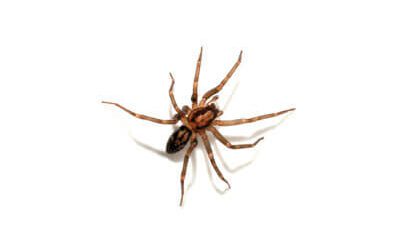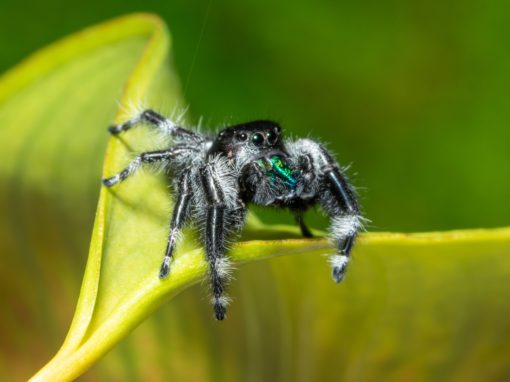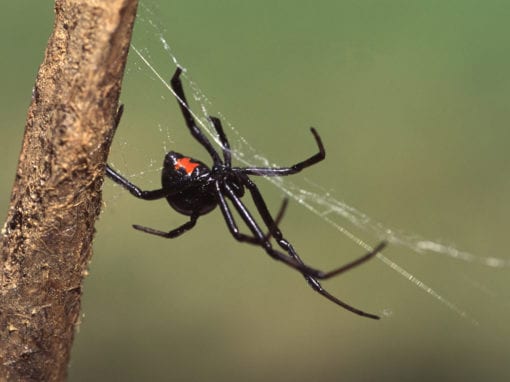Fall is spider season in more ways than one! It’s common to see large decorative spiders, as well as real ones outside and inside our homes during this time of year. Opposed to their scary depictions in Halloween media, real spiders are nothing to fear! Below are some cool spider facts, some common species we may encounter here in the Midwest, and which spiders to worry about.
by Allison Beach: Franklin Pest Solutions Technical Team
Arachnids vs. Insects
Spiders are not insects, but a closely related, exoskeleton-having animal called an arachnid. Both animals are part of a larger group called arthropods, which includes lobsters and crabs, too! A few main differences between arachnids and insects are:
- Arachnids have eight legs, while insects only have six.
- Arachnids don’t have three main body segments like all insects do (head, thorax, and abdomen). For example, spiders only have two segments (called a cephalothorax and abdomen).
- Arachnids don’t have wings the way some insects do (although small spiders CAN fly using silk as a sort of sail and riding with the wind. It’s called ballooning!).
- Arachnids don’t have antennae, while all insects do.
Spiders are carnivores and eat almost exclusively other arthropods. They are considered beneficial because this all-arthropod diet often includes pest insects we don’t want around (flies, stink bugs and cockroaches to name a few). They help do pest control for us!
One awesome thing about spiders that sets them apart from other arthropods is their ability to use silk to make webs! Not all spiders make webs; some live and hunt for prey on foot (all eight of them)! Some spiders work long and hard as little artisans to weave silk into intricate, impressive patterns. What is the point of a web? Webs have many purposes in addition to looking pretty when the sun hits them just right. Here are a few:
- Webs are spiders’ main mechanism for catching other arthropods to eat! Spiders use silk to make their own version of a sticky trap. Food crawls or flies in, becomes stuck, and the spider gets a free meal!
- They provide shelter and can be a shield against enemies.
- A well-constructed web can attract potential mates.
Common Spiders:
Wolf Spiders:
These brown spiders have characteristic light stripes near their eyes and are very common house/outdoor pests. They range in size from ¼ of an inch to over 1 ½ inches! Something interesting about wolf spiders is that they don’t build webs at all. They are what are called “hunting spiders” that hide during the day and come out to catch prey at night. Instead of a web, these spiders will build silk “retreats” in the ground, under rocks or wood, or under siding. They look a bit like a silk tunnel.
Orb Weavers:
Orb weavers are large, often brightly colored spiders that appear outdoors during the Fall season. Females weave a large web to catch prey between two sturdy materials (two branches, the pillars of a porch, etc.) and will rest right in the middle, hanging upside-down! These spiders can range in size/color, but they typically have a very large abdomen. Orb weavers exclusively build their webs outdoors and are commonly found near foliage (where their prey is), but also might be seen making webs on the outside of structures. This time of year, orb weavers become diurnal and are active on their webs during the daytime. Orb weavers do not bite unless extremely threatened but might seem to “vibrate” in the middle of their webs when someone gets close. This is to confuse predators!
Joro Spiders, a non-native orb weaver, have been in the news lately as being a dangerous, invasive spider that we should fear. The truth is that these spiders are as harmless as any other orb weaver we may see in the Midwest.
Common House Spiders:
House spiders are the reason so many of us have cobwebs in our homes and basements. These small spiders are attracted to damp, dark, quiet areas like basements and crawlspaces. These spiders like to build webs in corners of walls, floor joists, and windows: common places we see cobwebs. House spiders often abandon their web to make another, causing those annoying cobwebs to build up in homes. Although these spiders may be living in close quarters with us, they are nothing to be afraid of. They very rarely will bite, and only do so when they feel VERY threatened.
Cellar Spiders:
The name doesn’t lie! These tiny, long-legged spiders like to make their webs in dark, quiet spaces like basements/cellars, garages, and warehouses. They are known for their very long legs, and long, oblong behind (abdomen). Their mouth parts cannot pierce human skin. Cellar spider webs are pretty chaotic and look like a jumble of silk threads, very closely resembling cobwebs. These spiders can live for over three years in a structure.
Jumping Spiders:
Jumping spiders are another group that don’t make webs to catch their food, but hunt. They make silk retreats just like wolf spiders do. These spiders are on the chunkier side, with stout, furry bodies and short legs. Just like their name, they move very fast and tend to “pounce” on their prey! Contrary to other spiders, they are diurnal and tend to hunt in the light of day.
Grass Spiders:
Grass spiders, like their names, prefer to build their webs in yards and around landscaping. These spiders have very distinct, sheet-like webs with a little funnel “hidey-hole” off to one side. In the mornings, these webs may be very easy to see because they are covered in dew! Similar to the overwintering pests mentioned in the last blog, grass spiders will try to enter structures when temperatures start to drop.
Spiders to Worry About??
Spider bites are always a #1 concern. Spiders are pretty shy animals and will NOT bite people unless they are provoked and feel threatened. Spiders are pretty smart and know not to try to feed on humans because we are WAY too big! Common spiders like the ones described above can bite when threatened or trapped but are proven to be harmless health-wise. Their mouthparts are much too small to severely harm human skin, and they only carry enough venom to paralyze their tiny insect prey. Below are the only two spiders of health importance we may (rarely) encounter here in the Midwest:
Black widow spiders:
Everyone knows the orange/red “hourglass” shape that characterizes the black widow from other spiders. Females weave their webs closer to the ground, commonly in animal burrows, the bases of rock or bushes, or near the foundations of houses. Black widows usually stay in these webs to catch prey, so bites are rare unless they feel threatened. They are one of the spiders to worry about. Bites are painful and can produce symptoms like fever, convulsions, itching, nausea, and muscle pain, but rarely are lethal.
Brown recluse spiders:
These medium, brown, hairless spiders are reclusive and shy, just like their name. Brown recluse spiders have many look-alikes (there are lots of brown spiders in the world), but can be identified by a dark, fiddle-like marking on the first segment of their body. They like to hide and build retreats in small, dark, quiet spaces inside homes. Because they are non-native spiders they can’t survive outside. They are also nocturnal, and easy to go unnoticed in homes. They do not build webs. Brown recluse spiders only bite when they are extremely threatened or their retreat is being invaded, for example looking in untouched storage spaces. Bites typically aren’t painful, but can cause skin necrosis.
Did a Spider Bite Me?
When someone notices a mystery bite on their body, it’s common for spiders to take the blame. Spiders, like all other biting arthropods, can’t be identified through bites on the skin alone. The only way to truly know if you’ve been bitten by a spider is if you see it happening and catch them in the act!












